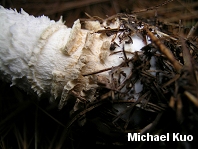| Major Groups > Gilled Mushrooms > Pale-Spored > Amanita > Amanita muscaria var. guessowii |

|
Amanita muscaria var. guessowii [ Basidiomycetes > Agaricales > Amanitaceae > Amanita . . . ] by Michael Kuo This variety of the well known species Amanita muscaria is distinguished by its yellow to orange, rather than red, cap. Other trademark features are shared with the red version: numerous warts on the cap, a ring on the upper stem, and a distinctive stem base that features several shaggy "zones" of universal veil material on the upper edge of a basal bulb. Amanita muscaria var. guessowii is found in the northern Midwest and in eastern North America from the boreal forests of the northeast, south to the Appalachians. In northern Michigan Amanita muscaria var. guessowii fruits in great quantities, regularly attaining dinner-plate size. Since it is a fairly gregarious mushroom, one often finds large troops of these mammoth Amanitas lurking under quaking aspen at the edges of fields. Compare this mushroom closely with Amanita muscaria var. flavivolvata and Amanita muscaria var. persicina, both of which have ranges that partially overlap the range of var. guessowii. Also compare with Amanita gemmata and Amanita russuloides, which can look superficially similar but feature very different stem bases. This mushroom is often featured in field guides as "Amanita muscaria var. formosa," but the variety name formosa designates a European variety (and one that is not consistently described in European literature). However, the varietal epithet guessowii represents a North American mushroom, and was first applied by Veselý (1933) to recognize the version of Amanita muscaria described by Hans Güssow, a Canadian author. The taxonomy of the Amanita muscaria species group will very likely change in the near future. A 2006 study by Geml and collaborators found DNA support for the idea that the color of the cap and warts in Amanita muscaria is not necessarily indicative of phylogenetic differences. The study used molecular dating techniques to hypothesize that "[t]he ancestral population of A. muscaria likely evolved in the Siberian-Beringian region and underwent fragmentation . . . The data suggest that these populations later evolved into species, expanded [sic] their range in North America and Eurasia" (225). As for the traditional morphological features separating "varieties," the researchers noted that among the species determined by DNA, "[a]ll . . . share at least two morphological varieties with other species, suggesting ancestral polymorphism in pileus and wart color pre-dating their speciations." Description: Ecology: Mycorrhizal with hardwoods and conifers; growing alone, scattered, or or gregariously, sometimes in arcs or fairy rings; summer and fall; widely distributed in the northern Midwest (south to Illinois) and in northeastern North America (south to the Appalachians). Cap: 5-19 cm; nearly round at first, becoming convex, broadly convex, or nearly flat in age; bald; pale yellow to bright yellow, reddish orange, or orange-yellow, fading with age; adorned with numerous whitish to yellowish, cottony warts (or, sometimes, felty patches); sticky when fresh; the margin usually slightly lined. Gills: Narrowly attached to the stem or free from it; white; close or crowded; short-gills infrequent, usually confined to the marginal area. Stem: 6-30 cm long; 1-3.5 cm thick; usually tapering to apex and flaring to an enlarged basal bulb; typically somewhat shaggy; white; with a fragile, whitish, skirtlike ring that sometimes features a yellowish edge; with concentric, rim-like bands of universal veil at the top of the bulb. Flesh: White throughout; unchanging when sliced. Odor: Not distinctive. Chemical Reactions: KOH negative on cap surface. Spore Print: White. Microscopic Features: Spores 9-14 x 5.5-8 µ; smooth; broadly ellipsoid; inamyloid. Basidia 4-spored; often basally clamped. Pileipellis an ixocutis of hyphae 2-9 µ wide. Lamellar trama bilateral; subhymenium ramose. REFERENCES: Veselý, 1933. (Kauffman, 1918; Jenkins, 1986; Phillips, 1991/2005; Lincoff, 1992; Barron, 1999; Roody, 2003; Geml et al., 2006; McNeil, 2006; Kuo & Methven, 2010; Tulloss, 2013.) Herb. Kuo 09019512, 11220403, 11220406, 09150712, 11020908, 10101005. This site contains no information about the edibility or toxicity of mushrooms. |
© MushroomExpert.Com |
|
Cite this page as: Kuo, M. (2013, April). Amanita muscaria var. guessowii. Retrieved from the MushroomExpert.Com Web site: http://www.mushroomexpert.com/amanita_muscaria_guessowii.html |







